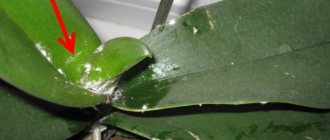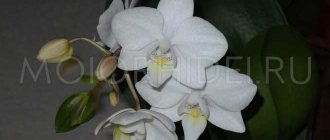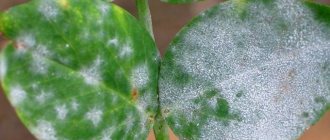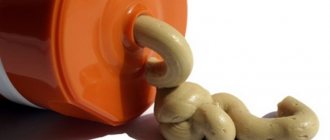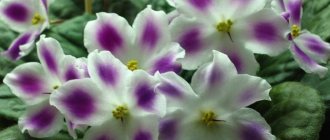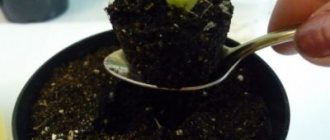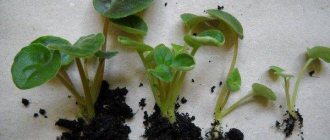Violet belongs to a variety of flowers that seem ordinary when compared with other specimens, but upon close contact it becomes an indispensable decoration for your windowsill. Moreover, the flower has a very long flowering period. By providing minimal quality care, you can enjoy beauty almost the entire season. The predecessor of the house violet is Saintpaulia, which once grew on the rocky terrain of the African savannah. Active selection of this plant began at the beginning of the 20th century. Currently, there are 8,500 species and varieties of domesticated violets. This is a quantity that is very difficult to master. Each species has its own varietal characteristics and, accordingly, regionalized cultivation methods. But the relationship of the plant to the soil composition and sufficient, proper nutrition remains the same on the territory of any country. Thus, having decided to plant violet plantings on your windowsill, you need to decide on the variety, and most importantly, familiarize yourself with the growing rules, in particular, what kind of soil for violets will be needed. If everything is done correctly, this process will not be particularly difficult, the plant will develop well, bloom abundantly and efficiently for a long period.
Our article is devoted to the direct rules for preparing the soil for replanting Saintpaulia, and the nutritional composition of the soil for violets in general. There are varieties that are more scrupulous about the composition of the soil, some are completely undemanding, so when choosing a variety, you need to familiarize yourself with all the varietal characteristics and select the best option for yourself. The most popular among flower growers, but also the most demanding in terms of growing conditions, is the Dance of the Galaxy variety.”
What to look for when choosing soil for violets
photo: soil for violets
Choosing the right soil for violets is a responsible process. The life of the flower practically depends on your choice: the external characteristics of future bushes, proper development, the ability to flourish abundantly and for a long time. Soil nutrition is of course an important point, but there are still points where several criteria must be taken into account: - the soil must be well saturated with oxygen, that is, the necessary breathability. How to achieve this, what actions to take: add baking powder to the soil. This material can be purchased at a flower shop. For example, coconut fiber, perlite, vermiculite. Without such devices, the soil layer very quickly turns into a lump, and this is a direct provocation for the beginning of rotting of the root system; -moisture content in the soil. In other words, the ability of the soil to retain a sufficient amount of moisture. A deficiency or excess will lead to serious consequences; - the need for potassium and phosphorus content. An insufficient quantity will affect the process and quality of budding. That is, the violet loses its ability to bloom. The leaves begin to turn yellow and curl. The appearance is lost and the health of the plant is weakened.
The listed criteria are the basis for growing indoor violets. When a flower grows in the wild, the attitude towards the composition of the soil is slightly different; the violet adapts to different conditions in order to survive. Home conditions are a slightly different parameter. In our rooms we are already growing Saintpaulia hybrids and therefore the requirements for conditions are changing. These varieties are the most vulnerable, capricious, delicate; poor soil composition can destroy the plant in a short period.
What kind of soil does violets need based on soil composition?
Varieties of varieties suggest the presence of specific preferences, for each individually. Some species of wild violets prefer hilly, mountainous areas, sunny meadows, while others thrive in shaded gorges and thickets of various shrubs. Some feel very comfortable in wetlands. Another small part can take root well in soils of poor composition, where an arid climate predominates. For Saintpaulia hybrids, most of these conditions are simply unacceptable; the plant can and will grow, even be able to develop a little, but the effect of a beautiful violet will no longer be there.
The distribution of Saintpaulia is large-scale, growing in areas of the Arctic, then throughout the entire adjacent territory to Tierra del Fuego. It is precisely because of this distribution that home violets have different requirements for the quality and composition of the soil. You can observe violets growing wild even in coastal dunes and semi-deserts.
There are a number of plant species that differ most in quality, abundance, duration and flowering efficiency - Duchess, Wedding Bouquet, Ice Rose, Amadeus.
Ready soil for violets: Composition. Purposeful application. Minuses.
Almost every gardener wonders how to choose the right soil composition so that the plant can feel comfortable, develop healthy, and feel great. There is a very large selection of purchased materials, but comprehensive recommendations for creating the necessary soil yourself. What to choose. Let's consider both options. Experience shows that collecting the soil composition with your own hands is the highest quality and most effective method. When buying soil mixture in a store, you can simultaneously acquire a number of problems.
Let's highlight a few problematic issues:
- When preparing the soil in production, it does not undergo the high-quality sterilization that you can provide at home. When a manufacturer is completely unscrupulous about his business, then the soil treatment before packaging does not undergo any treatment at all. Therefore, a change in a number of chemical indicators occurs in the composition;
- It is not known how the soil was collected into bags, so there is always a risk of acquiring soil along with various parasites and diseases, especially since this substrate does not undergo treatment. Infected soil will simply destroy your plants without even allowing them to develop;
- The soil mixture in production is subjected to the application of a certain composition of fertilizers. But no one can guarantee a deficiency or excess of constituent substances;
- Poor quality behavior from the manufacturer leads to savings in purchasing high-quality material, so the almost black soil offered in the store has the ability to acidify very quickly;
- As an advice, take this: when you don’t have time to make a soil mixture yourself and still buy soil in a store, always pay attention to the color of the soil, brown with a reddish tint, coarse-fibered peat is the correct color and composition of the soil mixture.
The best soil for violets: varieties and varieties
Below we list the most popular store-bought soil options for violets.
- ASB GREENWORLD , made in Germany, universal composition. Ingredients: nitrogen, phosphorus, potassium. Acidity is according to standards for growing violets. Average cost.
- Fusco (flower happiness) is a specialized soil for growing indoor violets. The soil is based on topsoil peat. Ready material for planting. Average cost per package.
- Klassman TS-1 , German origin, good homogeneity, no lumps. For this soil there is a need to add perlite. The disadvantage of this composition is that there is no piece sales, only small wholesale. The price criterion is quite inexpensive.
- soil for violets Coconut - subject to treatment against parasites and various bacteria. At least this information is on the label. The composition is very compact, the period of use is at least 5 years. However, the problem is that there is no sale on the Russian market. This soil has high salinity, and its cost exceeds the average statistics.
Important point!!! Before planting, you need to make sure that the soil is properly treated. Sometimes the information on the package is not enough, so it is recommended to always sterilize even purchased material. The simplest compositions also fall under this criterion: turf, leaf layer, manure, humus. All formulations must undergo home disinfection.
Soil mixtures such as Saintpaulia Biotech, Garden of Miracles, Garden and Vegetable Garden , consisting of low-lying peat, which tend to quickly compact, which will negatively affect the plant, are strictly not recommended for growing violets, despite the information on the packaging. But! This composition is perfect for preparing a homemade soil mixture.
Any, even the highest quality soil for violets, tends to deplete, because the plant continues to feed and develop. And a useful composition will not come out of nowhere on its own. Therefore, it is important to know what fertilizer and for what variety you need to purchase and apply in a timely manner in order to avoid disrupting the proper development of the plant.
Recipes for Klassmann peat-based substrates for violets
Based on this peat mixture, various substrates are prepared, suitable for violets of different ages, but not only.
Klassman can be the basis for self-production of soils.
Important! The Klasmann peat substrate itself is a complete medium for growing various plants, including violets.
Various additives can be added as desired. This can be agroperlite, expanded clay, etc. The peat/perlite ratio is selected for different age categories of violets:
- for cuttings - ratio of Klasmann TS1 peat: perlite, 1:1;
- for children with top-bottom watering - Klasmann TS1: perlite, 90:10;
- cultivation of starters and adult violets on wick irrigation - Klasmann TS1: perlite, 60:40 or 70:30.
It is better to mix peat mixture with perlite.
It is better to buy large perlite and be sure to rinse it before use. There is a lot of dust on it, which binds the substrate, significantly worsening its properties.
Necessary soil for violets with your own hands.
No matter what quality of soil mixture you purchase, there is always a need to add raising agents. That is why it is recommended to make the composition yourself, so to speak, with your own hands.
Let's consider two ways to obtain the necessary soil:
1) Baking powder and peat. For bottom soil, it is necessary to systematically add the entire useful composition. 2) Complex mixtures - soil, which includes the entire list of nutrition necessary for violets.
It is important to remember that all components for soil, naturally except fertilizers, undergo mandatory sterilization. It is easier and more convenient to do this in the following way: treat with a chemical composition. A safer and more convenient way is to heat it in the oven, pour boiling water over it, and freeze it in the freezer. Of course, all these processes will take more time, but it is environmentally safe for plants and humans.
After thermal treatment of the soil, it is necessary to use a solution of Fitolavin-300 or Trichodermin. How to explain? Completely sterile soil can easily absorb all microbes, bacteria, and spores of various fungi from neighboring plants, and the reproduction of these parasites occurs most rapidly when the soil is sterile. These drugs are useful microorganisms with which you populate the soil; they are capable of independently fighting all pathogens.
Every experienced gardener has a number of excellent recipes for creating optimal soil.
Below we list the recommended compositions:
- peat + 50% required soil + 20% perlite + 20% moss + 10% soil of good nutritional composition + charcoal;
- nutritionally enriched soil 70% + moss 10% + perlite 10% + 10% charcoal;
- nutritious soil and peat in a ratio of 1:3 + 1 part perlite and charcoal.
Many people use additional additives of folk origin: ground eggshells, compost, dolmite flour, soil with pine needles, river sand. All these components add a certain looseness to the soil, good air exchange, and excellent water permeability. Although without these components, the listed compositions can create ideal conditions for growing violets. The rest is just an addition and is used at the discretion of each person.
You can prepare the soil for future use, just follow proper storage: place it in a box or other container, cover the inner layer of the container with polyethylene and then place the substrate there. Close the lid. The soil should be checked periodically to avoid drying out, and it is advisable to limit the access of air flow.
How to prepare your own soil mixture?
If you decide to make your own primer, study the composition that is needed for different cases. For example, in the case of wick irrigation, special requirements will be placed on the soil.
For wick irrigation
We have already determined what kind of soil violets like, but we will not forget to repeat that the soil used for wick irrigation should:
Therefore, it is worth enriching the purchased mixture with vermiculite, agroperlite, and sphagnum moss.
Disinfection
The ready-made store-bought mixture is completely sterilized before sale, so it does not require disinfection, but you can add a little crushed charcoal to it.
If you collected the soil yourself, it needs to be calcined in the oven for several hours.
The need for additives.
Below we will try to most briefly but clearly describe the need for any additive, excluding fertilizers, which categorically affect the development of violets:
- Perlite is a volcanic glass of acidic composition. What are the advantages - the thermal effect is preserved; if a temperature difference occurs, it will protect you from hypothermia.
- The drainage layer will significantly reduce the acidity of the soil.
- loosening process - promotes timely absorption of soil during watering. vermiculite
- mulching.
- aeration. Reduces acidity in the soil, creates protection for the root system during sudden changes in temperature. Promotes maximum rooting of cuttings.
- Sphagnum moss has all the properties that protect the plant from rotting, the occurrence and activity of bacteria, and prevents the appearance of fungus. If the moss is crushed and cut, good looseness of the soil is created. Acidity stabilizes to a slightly acidic consistency. Moss also creates the appearance and direction of a kind of mat to retain the necessary moisture. Promotes good rooting of leaves.
- peat is the basis for any soil composition, a substance of organic origin; for growing violets, it is advisable to use a lighter, top layer. What are the advantages: light, loose soil composition, good air permeability, creation of the necessary acidic environment, helps remove limescale. In such a substrate there is a reduced percentage of the presence of bacteria.
- dark layer of peat, low-lying - capable of retaining moisture, richest in composition in organic substances. The downside is that it is not recommended to use it undiluted.
Important points! It must be remembered that all the beneficial properties of moss are contained only in living form. Vermiculite and moss must be thoroughly washed before use. All additives are at your discretion, as is the amount of added composition. All recipes given are also only recommendations. All recommendations and advice on the composition of the soil and filling it with nutrients are not able to save the vial, provided that you have watered it incorrectly.
Conclusion! The health of the bush depends not only on the quality of the soil; there are several other points. In our article we consider only the qualitative composition and nutrition during the growth process. You can find out everything else in the additional materials.
Everything you need to know about violet soil
Do you know what soil is suitable for your violets? After all, how well the plant will develop depends on the correct soil.
It must combine the necessary nutritional value and the correct acidity. The soil must be loose enough to provide the roots with the necessary air exchange.
If the soil mixture is chosen incorrectly, the plant may become very sick or even die completely . Later in the article we will look at what kind of soil is good and how to compose it correctly.
Necessary fertilizer for violets.
The presence of the required amount of moisture, light lighting, compliance with the temperature regime are all important indicators for the full cultivation of violets. But! One of the first criteria is high-quality, timely nutrition with the necessary elements (fertilizers).
Of course, the plant consumes the entire set through the root system from the soil composition, but over time this amount of nutrients is depleted when consumed by the violet or is simply washed away during watering. This flower simply needs additional fertilizers; without them, violets slow down the developing process, the lack of elements affects the external and internal condition of the plant.
There are two most consumed types of fertilizer: 1) minerals; 2)organic.
The texture of the additives is different - granular, in the form of sticks, in a liquid state. We choose for ourselves which type is better and more convenient to work with.
Important point!!! It is strictly prohibited to use fertilizers without reading the instructions for use and the presence of restrictions for their use. Ignorance can lead not only to the death of the plant, but also to harm to humans, internal or external. From skin disorders to body poisoning. For the safety of the plant, it is necessary to comply with the recommended dosages.
We will consider several necessary and easy-to-use additives of organic and mineral composition: - NITROGEN - its presence is necessary especially for young violet bushes, it can strengthen the green mass; -PHOSPHORUS - the plant needs the element during active budding and with abundant flowering; -POTASSIUM - the presence of this drug contributes to the duration of flowering; -Amino acids and Vitamins - when these are added, the most productive consumption of nutrients by the plant begins, and their absorption is also enhanced.
It is always necessary to follow the rules for applying any type of fertilizing: -only apply the entire nutritional composition from above; - the process of applying fertilizing and the choice of dosage is important even with the slightest deviation from the norm, therefore it is better to give the violet less fertilizer than to oversaturate it with this composition, as a result of which regression in development may begin; - strict familiarization with the instructions and mandatory compliance with all points thereof; - you need to establish a timely feeding system and adhere to this scheme; - it is recommended to periodically change the soil by replanting it into a new one, since a set of fertilizers will not renew the composition of worn-out soil. Do not forget about the need to disinfect new soil; - the variety of various fertilizers is such that experienced gardeners recommend changing the composition periodically so that the plant does not develop habits. Then the substances will bring a less expected effect; -moisten the soil before applying fertilizer. It is not recommended to add additives to a dry substrate; -if the plant is a little sick at the time of feeding, do not apply fertilizers, leave this process until complete recovery. Already at that stage, the flower will need a dosage of nutrition to restore strength.
When you fully comply with all the recommendations and follow simple care rules, you can easily grow a beautiful, strong, beautiful, healthy plant, even from children or leaves. Young bushes are able to delight with their flowering for a long period.
Klassman peat for violets
Among the nutrient mixtures that are suitable for growing violets, Klassmann TS1-085 peat (originally Klasmann TS1-085) occupies a special place. Its mechanical properties and balanced composition will help you achieve excellent results when cultivating your favorite flower.
This completely ready-to-use nutrient substrate based on white high-moor peat is most suitable for cultivating violets, gloxinias, etc.
Klasmann TS1-085 is excellent for growing violets.
Description
High-moor peat itself is characterized by a low degree of decomposition, low content of mineral elements, and high acidity.
The optimal level of pH (acidity) and nutrient content for plants is achieved by applying lime and fertilizers. The peat mixture also includes:
The developed nutrient mixture provides the plant:
Thanks to the structure of peat, the roots of the violet will constantly be in a humid environment and at the same time will not lack oxygen . This promotes rapid development of the root system and violet growth.
Peculiarities
On the market, the Klasmann TS1 peat mixture is presented in several formulations , which differ in the size of the fractions of the peat included in their composition:
Each recipe has its own purpose in crop production.
Peat mixture Klasmann TS1-085 is characterized by the following indicators:
Characteristics of Klasmann TS1-085.
Recommendations for use
This substrate is ideal for growing violets on wick irrigation:
Agrochemical indicators
The substrate already has a balanced composition of macroelements (nitrogen, phosphorus, potassium), suitable for various crops.
If necessary, it can be used as a base by adding perlite, expanded clay, etc.
Peat mixture characteristics:
Mineral elements:
The moisture capacity of the substrate is 75-80%, the air capacity is 11-15%, the weight in terms of dry matter is 10%.
This characteristic allows you to create highly nutritious mixtures for a wide range of plants .
Bottom line.
Violet, or Saintpaulia, is a beautiful, slightly capricious plant. This applies only to indoor varieties. Proper, timely, high-quality care is necessary for the full development of the plant. Without following these rules, the plant is doomed to death. Only you can create comfortable conditions for the health of violets, unlike wild varieties that independently choose the conditions for their growth.
A healthy, high-quality soil condition gives positive results in any case, and can also protect a vulnerable plant from the appearance of pests and diseases that become destructive for violets, since medications are not able to cure fungal and viral diseases of Saintpaulia. The correct soil composition is the key to plant health!!!
